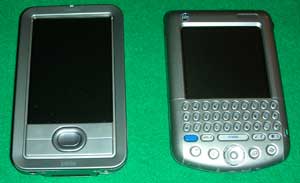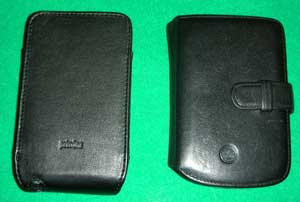My Palm Lifedrive arrived this week. With all the craziness going on with our network, I didn’t get around to playing with it much until this weekend. The jury is still out, but right now I’m not so sure that this was such a great upgrade.
 The appeal of the Lifedrive is memory, specifically 4GB on a micro hard drive. With the increase in memory, Palm is now touting the device as a data storage unit in addition to organizer. The Palm desktop has been reworked, and in order to take advantage of these new data storage capabilities, it’s now much easier to transfer files between computer and PDA. The unit has a much better media player, and with its standard headphone jack, makes a passable MP3 player. There is also much more screen real estate, now coupled with the ability to view data in portrait or landscape mode as with the earlier Tungsten E5.
The appeal of the Lifedrive is memory, specifically 4GB on a micro hard drive. With the increase in memory, Palm is now touting the device as a data storage unit in addition to organizer. The Palm desktop has been reworked, and in order to take advantage of these new data storage capabilities, it’s now much easier to transfer files between computer and PDA. The unit has a much better media player, and with its standard headphone jack, makes a passable MP3 player. There is also much more screen real estate, now coupled with the ability to view data in portrait or landscape mode as with the earlier Tungsten E5.
The Lifedrive comes with both WiFi and Bluetooth. Applications are included which will synchronize with phones and other BT devices. The WiFi, combined with an enhanced browser in landscape mode, make this a great device for quickly surfing in airports and other hotspots where a laptop might be a bit bulky.
 Those are the good points – now for the not-so-nice. The unit is bulkier. While only slightly larger than my old Tungsten C, the difference makes it hard to carry in a pocket without looking weird. I used my Tungsten case to carry business cards, and it also had slots for spare memory cards, but the size of the Lifedrive case makes that impossible. The case is only for protecting the unit – none of this other really useful stuff. Even more aggravating, one must completely remove the case from the unit to use the device. With the earlier Tungstens, the case at least remained attached to the unit. However, with this, you’re now left holding two separate items – the device and the case, which can be very awkward. There are no slots or other connections on the device that would allow for the development of a case that merely opens, rather than one that must be removed.
Those are the good points – now for the not-so-nice. The unit is bulkier. While only slightly larger than my old Tungsten C, the difference makes it hard to carry in a pocket without looking weird. I used my Tungsten case to carry business cards, and it also had slots for spare memory cards, but the size of the Lifedrive case makes that impossible. The case is only for protecting the unit – none of this other really useful stuff. Even more aggravating, one must completely remove the case from the unit to use the device. With the earlier Tungstens, the case at least remained attached to the unit. However, with this, you’re now left holding two separate items – the device and the case, which can be very awkward. There are no slots or other connections on the device that would allow for the development of a case that merely opens, rather than one that must be removed.
Despite a faster processor, the unit feels sluggish. Accessing data from the microdrive takes a bit longer, so applications tend to open slower. This can get to be quite tedious.
 Probably the most aggravating thing about the Palm Lifedrive is the data input. The Tungsten C had the built-in keyboard, but more useful than that was the C’s ability to use the entire screen for Grafiti writing. The Life drive not only loses the keyboard in favor of a larger screen, but it takes a giant step backwards as far as stylus input is concerned. Data can only be entered in a specified window, similar to the old Palm Pilots. The Grafiti data input can be hidden so that it doesn’t take up the screen, but that simple action takes time, especially with the microdrive. It can get very annoying.
Probably the most aggravating thing about the Palm Lifedrive is the data input. The Tungsten C had the built-in keyboard, but more useful than that was the C’s ability to use the entire screen for Grafiti writing. The Life drive not only loses the keyboard in favor of a larger screen, but it takes a giant step backwards as far as stylus input is concerned. Data can only be entered in a specified window, similar to the old Palm Pilots. The Grafiti data input can be hidden so that it doesn’t take up the screen, but that simple action takes time, especially with the microdrive. It can get very annoying.
As an MP3 player, the device functions very well. However, if this is your only reason for buying the device, save about $400 and get a 1GB iPod Shuffle instead. You’re probably not going to want to use more than 1GB for music anyway if you’re using the device for other things.
All in all, the Lifedrive has promise, but I think Palm took too many shortcuts in implementation just so it could get a microdrive unit on the market before HP’s iPaqs moved that direction.